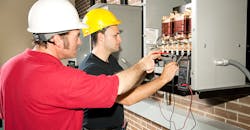5 Steps to Ensuring Maintenance Techs’ Safety
Maintenance is an important function in any manufacturing plant, ensuring equipment works as expected without any failure, thus improving overall plant performance. Maintenance technicians are obligated to make the work environment safe, but they face many challenges in performing their duties.
Maintenance technicians work with complex machinery that unfortunately has the potential to fail. The risk of injury and accidents is high when technicians work in such an environment. The safety risks they face can be divided broadly into two categories – accidents and long-term health problems.
Accidents. Accidents broadly represent events that cause immediate, physical injury or harm to the maintenance technician. The nature of accidents could be acute or catastrophic. Some accidents have the potential to be life-threatening, and some could require hospitalization for many days. Some of the common ways accidents occur (though, not an exhaustive list) are explosions/fire, slips and falls, impact with sharp objects, inhaling toxic fumes, noise impacting hearing, skin contact with toxic substances, electrocution, and radiation exposure.
These accidents have an instant impact and often require hospitalization.
Long-term health problems. Maintenance technicians have to perform repeated tasks throughout their careers, which can long-term health effects. Maintenance technicians have to reach remote positions, forcing them to adopt uncomfortable postures – which may lead to sustained injuries. Such problems may not manifest until later in life, and the treatment may be difficult and costly. There also is a risk of long-term mental strain.
A safe work environment
Maintenance technicians are commonly involved when there is a machinery failure. When they have to work in a hazardous environment, there is a high likelihood that they cannot complete their tasks, and this will mean that the operation is compromised and production may be delayed. The cost of such a maintenance disaster could be heavy.
The productivity loss is significant for the operation, and the plant and equipment may incur loss and damage. Fixing it requires additional capital investment. Hazardous work environments can cause physical harm to operators, maintenance technicians, and other stakeholders.
Operators and maintenance techs that suffered the accident will be out of the workforce for a few days, requiring replacements so operations may resume. A plant with a record as a dangerous workplace could find it difficult to hire new employees.
Having an unsafe environment has many direct and indirect costs to the factory and its stakeholders.
In order to reduce costs and improve the overall safe work environment, we recommend implementing the following five steps:
1. Training. Most maintenance problems occur due to the mistakes of technicians. Inexperienced technicians performing maintenance activities could lead to mistakes. It’s highly recommended to employ maintenance technicians who have sound technical knowledge and hands-on experience.
Without technical knowledge maintenance technicians may inadvertently cause mistakes that lead to accidents. Hands-on training is necessary so that technicians do not stumble while handling machinery in the workplace. Virtual simulations also may be employed to train maintenance technicians.
2. SOP and checklists. Errors occur when technicians perform their tasks according to their own styles. This introduces process variability, but it can be minimized by having standard ways of performing tasks.
Each maintenance activity should have a standard operating procedure (SOP.) Experienced technicians along with the support from OEMs should create SOPs for each maintenance activity. This will ensure that all maintenance techs have a standard way of performing maintenance tasks. Technicians that follow the SOPs have an extremely remote chance of faults during maintenance.
3. OSHA. The U.S. Occupational Safety and Health Administration (OSHA) establishes safety standards and practices to be followed for every industry, ranging from recommendations for protective gear to be used to elaborate protocols for managing particular tasks and equipment.
Access the relevant guidelines from OSHA and implement them in your manufacturing facility. This will significantly reduce the risk to maintenance technicians performing their duties.
4. Maintenance scheduling and prediction. When machines break down and technicians have to perform reactive maintenance, the chance of accidents occurring is very high. Performing regular maintenance reduces the chances of such a failure. If a machine does not break down, maintenance technicians only have to perform regular upkeep for scheduled maintenance – which will minimize the dangers technicians face.
Predictive maintenance also can be implemented to improve the safety of equipment on plant premises.
5. Emergency protocols. Even with all precautionary measures, there is a chance of hazards occurring while performing maintenance. There should be emergency protocols in place to be performed in such emergencies, including natural disasters, fire hazards, chemical leakage, electrocutions, etc. Any incident that could cause damage to people, property, or equipment can be counted as an emergency. The emergency protocols should cover the steps to be taken by various stakeholders in different crisis scenarios. You should create further protocols for all foreseeable scenarios. Also, train maintenance technicians with these protocols and help them to retain the steps in the protocol.
The safety of people, property, and equipment is a high priority in a manufacturing facility. Maintenance technicians work to ensure all equipment is operating in ideal conditions, to reduce the chances of failure. Ensuring the safety of maintenance technicians while they perform their duties is equally important.
Bryan Christiansen is the founder and CEO of Limble CMMS,a mobile CMMS software that helps managers organize, automate, and streamline their maintenance operations.
About the Author
Bryan Christiansen
Founder and CEO
Bryan Christiansen is the founder and CEO of Limble CMMS. Limble is a modern, easy to use mobile CMMS software that takes the stress and chaos out of maintenance by helping managers organize, automate, and streamline their maintenance operations.
